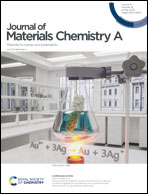Hexagonal MoO3 as a zinc intercalation anode towards zinc metal-free zinc-ion batteries†
Abstract
Aqueous rechargeable zinc-ion batteries (ZIBs) are attractive candidates for application in energy storage technology. However, the formation of Zn dendrites at a potential close to the Zn/Zn2+ redox potential can severely limit battery rechargeability and energy density. Herein, hexagonal MoO3 (h-MoO3) is proposed as an intercalation anode (discharge potential of 0.36 V (vs. Zn2+/Zn)) as a potential replacement for Zn metal plates for the first time and it showed a specific capacity of 120 mA h g−1 at 0.2 A g−1 with superior cycling stability. Furthermore, a zinc metal-free full cell was successfully demonstrated with this h-MoO3 anode and a Zn0.2MnO2 cathode. The cell delivered a specific capacity of 56.7 mA h g−1 which corresponds to an energy density of 61 W h kg−1 (based on the total mass of anode and cathode materials), higher than that of most aqueous zinc ion batteries. Furthermore, excellent cycling life was recorded as the full ZIB cell achieved ca. 100% of its original capacity after 1000 cycles. Based on the preliminary investigation of utilizing h-MoO3 as the ZIB anode, the results have shown significant promise in achieving Zn ion full batteries for energy storage applications.

- This article is part of the themed collection: Journal of Materials Chemistry A HOT Papers


 Please wait while we load your content...
Please wait while we load your content...